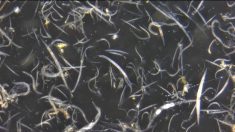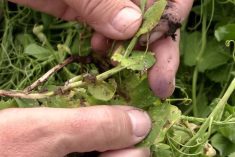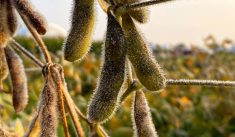Twenty years later in the making: improved genetic resistance to fusarium head blight in winter wheat
It has been 20 years since Manitoba experienced the most severe epidemic of fusarium head blight (FHB) on record. Since that time, significant progress has been made to mitigate the impact of FHB.
In the past, winter wheat tended to ‘escape’ FHB infection as it flowered prior to environmental conditions that favoured infection. However, as seen in recent years, FHB can have a negative impact to both yield and quality of winter wheat. As a result, breeders have begun a concerted effort to improve FHB resistance in winter wheat varieties. In fall of 2014, the first winter wheat variety to be rated Resistant (R) to FHB will be available to producers — Emerson, a variety belonging to the Canada Western Red Winter (CWRW) class. And another new CWRW variety, AAC Gateway, has an Intermediate (I) rating.
Read Also

Manitoba canola industry has new frontiers
Canola oil is still the main priority for the sector, but canola meal is increasingly the subject of research looking for new markets and uses for the oilseed’s byproduct.
So 20 years later, progress is being made in mitigating the risk of FHB through genetic improvements.
Evaluating reaction to fusarium head blight
So how are FHB ratings in Seed Manitoba determined? Official FHB evaluations have started for winter wheat in the Central and Western Winter Wheat co-operative registration trials. To determine reaction to FHB, candidate lines are tested for three years in nurseries that also contain check and supplementary varieties planted at regular intervals throughout the nursery. When rows reach 50 per cent anthesis within each individual plot, plants within that row are inoculated with a spore suspension, and then inoculated again three to four days later to infect later tillers. The nurseries are misted or irrigated, both after each inoculation and during the entire inoculation period.
Approximately 21 days after inoculation, the inoculated plants are rated for both incidence (per cent of heads with infection) and severity (average amount of infection on the infected heads) of FHB. Visual rating index (VRI) is then determined by the formula: VRI = per cent incidence x per cent severity / 100. The ratings have to take trial conditions, along with check and supplementary varieties’ reactions, into account.
The combination of inoculation under misted/irrigated conditions typically provides enough data to properly assign ratings. However, even with inoculation and misting, disease development is dependent on the right environmental conditions.
High temperatures on the day of inoculation may cause little disease to develop, so in some years, a low score may mean escape rather than resistance. This is where three years of testing plays an important role. After the three years of testing, some varieties undergo further evaluation, or performance in commercial fields is also used to assess reaction to FHB. Changes to the ratings found in Seed Manitoba may occur in order to provide the most accurate information to farmers.
Resistance does not equal immunity
With advances in breeding, it is imperative that farmers know that resistance or an R rating does not equal immunity. In fact, plants don’t have immune systems and therefore can’t be immune to any disease. Depending on the level of disease pressure, varieties that are rated as resistant will be infected to some degree. If disease pressure is high (i.e. high inoculum levels, conducive environmental conditions for a long period of time), yield loss due to FHB can still occur in R-rated varieties.
In Table 1, FHB reaction data collected in the co-operative registration system (as described above) is provided, illustrating how Emerson performed relative to other winter wheat check varieties and supplementary checks. Emerson showed a consistent improved reaction to FHB comparative to the resistant supplementary check, hence the R rating. But as the table also illustrates, the R rating does not equal immunity, as FHB was still measurable in each of the three years.
This is why it is still important to use more than one management practice. Extensive research over the past 20 years has shown that using multiple management options, including crop rotation, fungicide application, tillage, and variety selection, is the best way to mitigate the risk of FHB. But unfortunately, FHB infection will always be highly influenced by environment. Under high levels of the disease, all varieties will sustain damage.
2013 winter wheat performance data available
MCVET (Manitoba Crop Variety Evaluation Team) is publishing yield data collected in 2013 at five locations and updated variety descriptions that include two new registered varieties: Emerson and AAC Gateway (see Variety Descriptions Table). Additional site data, along with long-term yield data and protein data incorporating all the 2013 results, will be available December in Seed Manitoba 2014.
Multi-site data for 2013 can be found in the Yield Comparisons Table. Keep in mind that data accumulated over several sites in a single year must always be viewed with caution. Varieties that excel under one set of environmental conditions may not perform as well under the next year’s conditions. The new varieties of Emerson and AAC Gateway were tested for the first time in 2012-13, so additional caution must be exercised when evaluating the performance of these two varieties.
Special thanks are extended to all MCVET sponsors and supporters, including Winter Cereals Manitoba Inc. who provides funding for post-registration winter wheat variety evaluations.
Sources:
Graf, R.J., Beres, B.L., Laroche, A., Gaudet, D.A., Eudes, F., Pandeya, R.S., Badea, A. and Randhawa, H.S. 2013. Emerson hard red winter wheat. Can. J. Plant Sci. 93: 741-748.
Operating Procedures for Prairie Recommending Committee for Wheat, Rye and Triticale. 2012. APPENDIX D: Guidelines for Disease Resistance in Wheat and Triticale (Revised January 2010) & APPENDIX E: Disease Screening Protocols


















